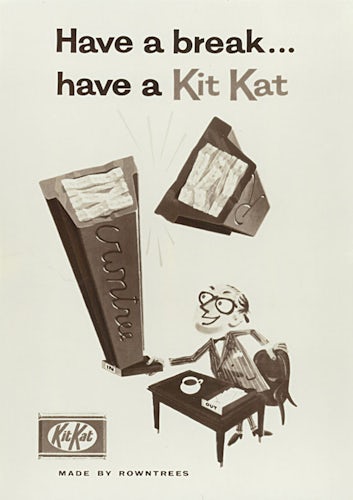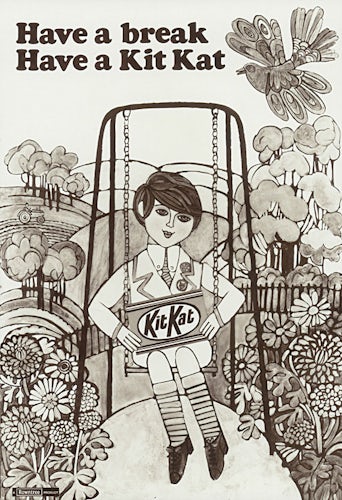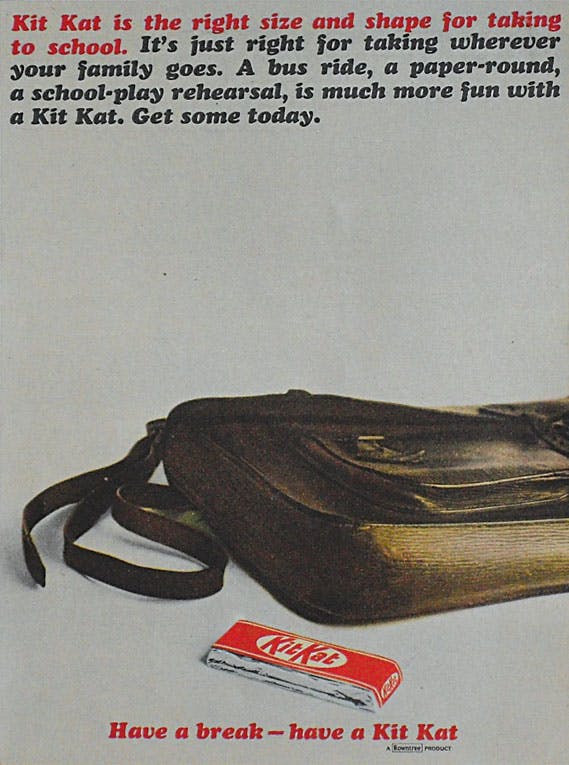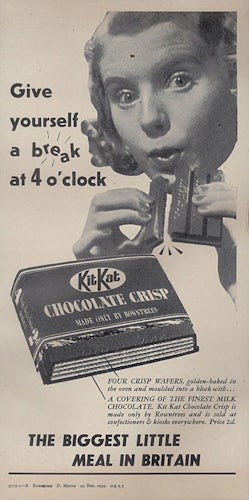06. Kit Kat (1957) – Have a Break Have a Kit Kat
Donald Gilles, JWT
In 1941 confectioner Rowntree’s of York was forced to change the recipe of its Chocolate Crisp bar because of wartime food shortages. Conscious of disrupting a loyal fanbase (the product came out of an employee suggestion that the company make “a chocolate bar that a man could take to work”) the company launched a new bar in a blue wrapper using the name, Kit-Kat, which the Chocolate Crisp had carried as a nickname since 1937. The tagline warned that there would be ‘No More Chocolate Crisp Till After The War’ and, when it finally did return to the shops, it only lasted until 1949 when it relaunched as the fully-fledged Kit Kat and its blue livery was replaced with red.

According to Nestlé historian Alex Hutchinson, the Kit Kat name had been registered by Rowntree’s in 1911 but its origins went back much further, to the name of an early 18th-century debating society. The Kit-Cat Club had met regularly in a tavern in Shire Lane in London, hosted by innkeeper Christopher Catling, known as ‘Kit Cat’ to his friends. Nearly 200 years later, the snappy moniker fitted with agency J Walter Thompson’s attempts to move away from the longer, more literal names used on Rowntree’s other products. During JWT’s early work with the brand, the idea of associating the Kit Kat bar with the enjoyment of a short break from the working day also began to develop.
The first use of the tagline ‘Have a Break. Have a Kit Kat’, written by the agency’s Donald Gilles, can be traced to May 1957. A year later it was used on the first television spots for the brand and ever since has been a staple of campaigns for the chocolate bar. Initially the line reflected the welcome 11am tea break – ‘elevenses’ – common to British factories. But as it became more widely used, particularly on television, the flexibility of the phrase became the key to its longevity. The benefits in taking a break from something could be applied to all manner of stressful (and potentially comedic) situations.
One popular TV spot from 1989, for example, depicted a photographer patiently trying to snap a pair of pandas in a zoo. Only while he is taking a break do they finally emerge – on roller skates.
Similarly irreverent humour had been used in a 1987 commercial, No Rest for the Wicked, which followed a devil and an angel enjoying a break from the routine of their respective ‘jobs’ in the foyer of an otherworldy office building.
In each (and there are dozens of TV commercials) the ‘Have a Break. Have a Kit Kat’ line worked because of its association with recognising life’s small defeats, rather than glorifying its triumphs. Interestingly, in the US in the 1980s the clauses were reversed so the line became the more instructive, but far more lumbering, ‘Give Yourself a Kit Kat. Give Yourself a Break’.
In another change of tack in 2001, the tagline took a back seat in a UK commercial that depicted a host of famous names such as Lemmy, Kelly Brook and Bernard Manning ‘taking a break’ from their own stereotypes. Manning suggests to his wife that her mother might like to come over for a visit (while doing the washing up) and the Daleks intone “Give. Us. A. Cuddle” while patrolling a shopping centre.
Despite these interpretations it’s the relationship to the workplace, specifically its recreation time, that keeps the Kit Kat tagline relevant. While Rowntree’s was bought by Nestlé in 1988, Kit Kat retains its Britishness and there’s something in the tagline that taps into our obsession with working life. But sport has played a part, too. During Wimbledon in 2010, JWT rushed out a site-specific Kit Kat ad after the longest tennis match in history had finally come to an end. After 11 hours of play, John Isner beat Nicolas Mahut 70–68 in the final set, resulting in a break no doubt welcomed by both players.

-
Post a comment




















